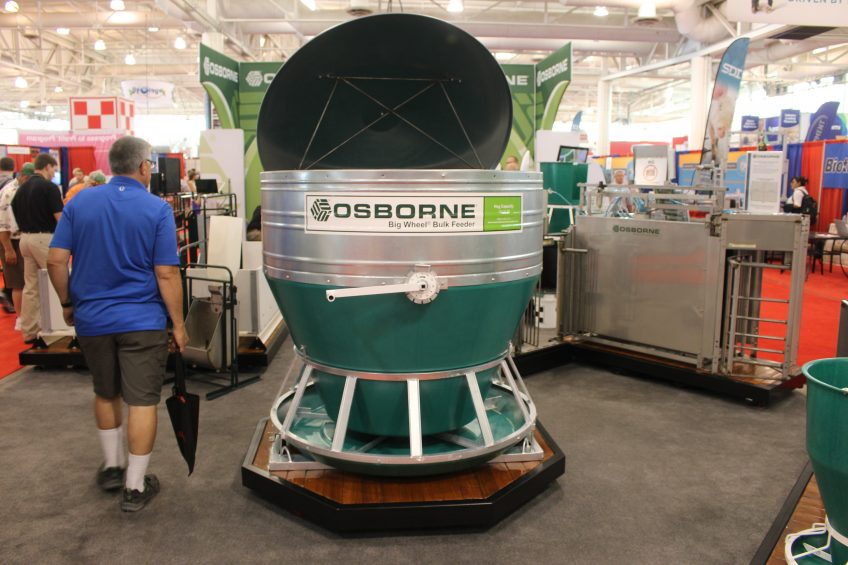World Pork Expo and the sustainability paradox

In order to feed the world sustainably, what is needed is far more advanced production methods. What sometimes happens appears to be the opposite: trends embracing organic. Pig Progress editor Vincent ter Beek found reflections of both at the recent edition of World Pork Expo, held 7-9 June in Des Moines, IA, United States.
It was hard to miss – right there in the middle of the booth of livestock equipment manufacturer Osborne Livestock Equipment, at World Pork Expo. A huge round bulk feeder, ready to feed… yes, what exactly? Lions? Hippos?
The answer is – of course – pigs, otherwise it wouldn’t have been on display at World Pork Expo. It is, however, meant for outdoor pigs, hence the spacious design.
Daily requests for bulk pig feeders
The design is not new, I was told, it has been around since the 1980s. For years, I learned, there hadn’t been much demand for it. And now, all of a sudden, almost daily new requests have started to come in, from all over the United States – not just the Mid-West, where most pigs are based.
So there it was, an outdoor feeder next to e.g the company’s Electronic Sow Feeding (ESF) stations or FIRE performance testers. Clearly nationwide the interest for hobby, outdoor and organic farming is growing and no wonder the company also jumped on this trend.
Paradox of livestock production
Essentially, producers following that explanation of ‘sustainable animal production’ think of key words like animal welfare, antibiotic-free, outdoor, organic and local.
Conversely, a complete opposite explanation of ‘sustainable animal production’ also protruded strongly at this year’s edition of World Pork Expo. In that vision, key words are precision, computerised, feed conversion, targeted and commercial. Sustainability is created by being able to provide tailor-made conditions for all animals on farms, using growing numbers of sensors, and thus be able to do a lot more with less, essentially reducing the ecological footprint.
No more empty bins
Various nice examples could be found of systems, where increasingly, modern technology is being used to manage the animals. A novel, simple concept, for instance is the application by SmartFarm Systems, from Michigan.

It comes with a sensor hanging inside a feed bin – once the bin is almost empty, a signal is sent to the owner or manager that a top-up is required. This way, producers will never find themselves in a situation of empty bins over the weekend.
Controlling sow feed curves and piglet temperatures
The Canadian company JyGa Technologies, well-known of the Gestal electronic sow feeders for use during lactation, are gradually expanding their network of possibilities and realising that ear tags and ESF offers more opportunities than just management. Some while ago, they introduced a feeder for during gestation – effectively a nice hybrid between an ESF station and a free access stall, at this edition they showcased the Gestal Quattro for in the lactation barn.

Essential for the concept is the stand-alone function of each feeder, which is wi-fi compatible and which can thus be operated from a handheld. In no-time, data can be analysed and a different blend can be offered if necessary. A new feature to the Gestal Quatrro is that it also has started to cover newborn piglets, as the device combines the same outlet as the heat lamp or mat. This way not only the sow’s feeding supplies can automatically be adjusted, but also the temperature for piglets.
Integrating data in a swine farm
On paper, the most far-reaching example of integrating data, could be found in the presentations by Maximum AG, a Michigan-based company which gradually integrated its one-stop pig house control panel with increasing levels of monitoring equipment.

In a thought-provoking presentation, Dr Tom Stein, the company’s senior strategic advisor, explained about the Internet of Things, Self-Learning Machines and painted an interesting picture of where the pig production could go to. Its control system, Maximus, is said to be compatible with many systems on the market, but not only control is possible – also analysis, using sensors of all kind. Feed supplies can be monitored, and so are air flow, lighting, water etc.
New ESF station
The system appears advanced – and Maximum AG also offered new addition at World Pork Expo: an own ESF station. This way, the software company moved into hardware, no doubt this is also about acquiring and controlling data.

In fact, this is where computerised management and animal welfare meet. Both the ESF hybrid by JyGa as well as the novel ESF station by Maximus, offer a feature that doesn’t come with traditional ESF stations: they can be placed in a row, right next to each other. That way, sows can eat simultaneously with their immediate neighbour – something that, I’m told, is close to a sow’s natural behaviour.











